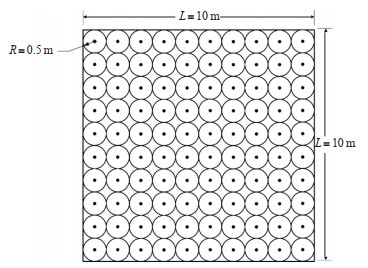An Evaluation of Connectivity of Transfer in Comprehensive Passenger Transport Hubs Considering Social Distance
-
摘要: 为降低新型冠状病毒肺炎疫情在综合客运枢纽内传播扩散的风险,枢纽内均要求行人保持一定的社交距离。针对现有研究缺乏评价社交距离对枢纽换乘衔接效果影响的问题,通过引入疫情传播扩散风险指标(该指标值越高,代表疫情传播风险越低)构建更新的评价体系。采用CRITIC-熵权法计算各评价指标的权重,并通过优劣解距离法(TOPSIS)评价模型对不同社交距离下的换乘衔接效果进行评价分析。以重庆西站为例,通过Anylogic软件模拟换乘衔接情况,输出各项评价指标值。结果显示:平均客流密度过高点位数、进站口排队时间、进站时间和进站率对综合客运枢纽换乘衔接效果评价的影响较为显著;使综合客运枢纽换乘衔接效果最优的社交距离为1 m,且相对于社交距离为2,1.5,0 m,换乘衔接效果综合评价水平分别提高60.53%,34.50%和25.71%,其中进出站时间指标和进出站效率指标评价值平均提高20.86%和47.79%,疫情传播扩散风险指标评价值平均提高53.74%;当不进行社交距离限制时,换乘衔接效果综合评价水平平均降低7.77%,进出站时间指标和进出站效率指标评价值分别平均提高47.08%和60.00%,而疫情传播扩散风险指标评价值平均低70.09%。
-
关键词:
- 交通规划 /
- 综合客运枢纽 /
- 换乘衔接评价 /
- TOPSIS评价模型 /
- CRITIC-熵权法 /
- 社交距离
Abstract: In order to reduce the risk of the spread of the COVID-19 in comprehensive passenger transport hubs, passengers are required to maintain a certain social distance. In response to the lack of literatures regarding the influences of keeping social distance on connectivity of transfer in the transport hubs, an improved index systemis proposed to reflect the impacts of keeping social distance by introducing an index of riskof epidemic spreading (the higher the value of the index, the lower the risk of epidemic spreading). Specifically, the CRITIC-entropy weight method is used to calculate the weight of each index, and the TOPSIS evaluation model is used to analyze the connectivity of transfer in comprehensive passenger transport hubs with different social distances. Taking Chongqing West Railway Station as a case study, the corresponding connectivity of transfer is simulated by Anylogic software, then the value of each evaluation indexis output. The results reveal the following conclusions. First, indices including the number of over-density points of average passengers flow, queuing time atstation entrances, entry time, and entry rate have significant effects on the evaluation of passengers' transfer in comprehensive passenger transportation hubs. Second, thesocial distance for optimal connectivity of transfer is 1 m, comparing to the social distance of 2, 1.5, and 0 m, its comprehensive evaluation level of connectivity increases by 60.53%, 34.50%, and 25.71%, respectively. In detail, the values of indices of entry-exit time and efficiency averagely increase by 20.86% and 47.79%, respectively. The value of index ofrisk of epidemic spreading averagely increases by 53.74%. Third, when no social distance restriction is imposed, the comprehensive evaluation level of connectivity averagely decreases by 7.77%, and the values ofindices of entry-exit times and efficiencies increase by 47.08% and 60.00%, respectively, while the value of index of risk of epidemic spreading is 70.09% lower on average. -
表 1 平均客流密度服务水平等级
Table 1. Average passenger flow density service level
等级 客流密度λ/(人/m2) A λ≤0.4 B 0.4<λ≤0.75 C 0.75<λ≤1.3 D 1.3<λ≤1.75 E 1.75<λ≤2.3 F λ>2.3 表 2 综合客运枢纽换乘衔接效果评价指标体系
Table 2. The evaluation index system of the transfer and connection effect of the comprehensive passenger hub
准则层 指标层 指标属性 进出站时间/min 平均进站时间 负向 平均出站时间 负向 进站口排队时间 负向 进出站效率/% 进站率 正向 出站率 正向 疫情传播扩散风险 平均客流密度/(人/m2) 负向 密度超过0.75人/m2点位数/个 负向 表 3 Spearman假设性检验
Table 3. Spearman hypothesis test
检验对象 检验指标 密度数 平均密度 排队时间 进站时间 出站时间 进站率 出站率 客流量 相关系数 -0.576** -0.554** -0.441** -0.087 -0.308** -0.233 -0.298* p值 0 0 0 0.479 0.01 0.054 0.013 社交距离 相关系数 0.463** 0.351** -0.185 -0.931** -0.766** -0.859** -0.516** p值 0 0.003 0.128 0 0 0 0 注:*表示p < 0.05;**表示p < 0.01。 表 4 换乘衔接效果评价指标权重
Table 4. Weights of evaluation indicators for transfer and connection effect
单位: % 准则层 评价指标 熵权法 CRITIC 综合 总计 疫情传播扩散风险 密度数 39.70 30.55 35.13 41.09 平均密度 3.91 8.01 5.96 进出站时间 排队时间 8.08 19.56 13.82 36.08 进站时间 15.68 16.01 15.85 出站时间 5.41 7.41 6.41 进出站效率 进站率 22.99 12.36 17.68 22.84 出站率 4.23 6.10 5.17 表 5 不同社交距离下二级评价指标的评价值水平
Table 5. Evaluation levels of the second-level evaluation indicators under different social distances
社交距离/m 密度数评价值/% 平均密度评价值/% 排队时间评价值/% 进站时间评价值/% 出站时间评价值/% 进站率评价值/% 出站率评价值/% 0 0.151 0.774 0.989 0.991 0.944 0.751 0.828 1 0.904 0.877 0.817 0.876 0.895 0.703 0.835 1.5 0.855 0.877 0.590 0.454 0.842 0.410 0.776 2 0.648 0.713 0.900 0.284 0.577 0.119 0.563 表 6 不同社交距离下一级评价指标的评价值水平
Table 6. Evaluation levels of the first-level evaluation indicators of different social distances
社交距离/m 疫情传播扩散风险评价值/% 进出站时间评价值/% 进出站效率评价值/% 综合评价水平评价值/% 综合排名 0 0.099 0.354 0.176 0.629 3 1 0.370 0.309 0.167 0.846 1 1.5 0.353 0.207 0.113 0.673 2 2 0.270 0.206 0.050 0.527 4 -
[1] 赵政宇, 姚加林. 基于多级可拓评价法的高铁客运枢纽换乘评价[J]. 铁道科学与工程学报, 2016, 13(12): 2347-2354. doi: 10.3969/j.issn.1672-7029.2016.12.005ZHAO Z Y, YAO J L. Evaluation of transfer at high-speed railway passenger terminal based on multi-level extensible method[J]. Journal of Railway Science and Engineering, 2016, 13(12): 2347-2354. (in Chinese) doi: 10.3969/j.issn.1672-7029.2016.12.005 [2] 周继彪. 综合交通换乘枢纽行人交通特性及安全疏散研究[D]. 西安: 长安大学, 2014.ZHOU J B. Research on Pedestrian traffic characteristics and safe evacuation of integrated transportation interchange hubs[D]. Xi'an: Chang'an University, 2014. (in Chinese) [3] 郭伟, 姚加林. 基于IAHP-熵权法和Vague集的高铁客运枢纽离站换乘评价[J]. 工业工程与管理, 2022, 27(2): 18-25. https://www.cnki.com.cn/Article/CJFDTOTAL-GYGC202202003.htmGUO W, Y J L. Based on IAHP-entropy weight method and Vague set, high-speed rail passenger terminal departure transfer evaluation[J]. Industrial Engineering and Management, 2022, 27(2): 18-25. (in Chinese) https://www.cnki.com.cn/Article/CJFDTOTAL-GYGC202202003.htm [4] 张瑞, 李静婧, 刘葛辉, 等. 地铁车站客流瓶颈识别与疏解方案优化研究[J]. 交通信息与安全, 2019, 37(2): 128-134. doi: 10.3963/j.issn.1674-4861.2019.02.018ZHANG R, LI JJ, LIU G H, et al. Identification and optimization of resolving bottleneck for passenger flow in metro Stations[J]. Journal of Transport Information and Safety, 2019, 37 (2): 128-134. (in Chinese) doi: 10.3963/j.issn.1674-4861.2019.02.018 [5] GE Y, CHEN Z, HANDEL A, et al. The impact of social distancing, contact tracing, and case isolation interventions to suppress the COVID-19 epidemic: A modeling study[J]. Epidemics, 2021(36): 100483. [6] 周继彪, 马昌喜, 董升, 等. 新冠肺炎疫情下城市公共交通非常规防疫策: 以宁波市为例[J]. 中国公路学报, 2020, 33 (11): 1-10. doi: 10.3969/j.issn.1001-7372.2020.11.002ZHOU J B, MA C X, DONG S, et al. Unconventional prevention strategies for urban public transportation under the new crown pneumonia epidemic: A case study of Ningbo city[J]. China Journal of Highways, 2020, 33(11): 1-10. (in Chinese) doi: 10.3969/j.issn.1001-7372.2020.11.002 [7] 胡松, 翁剑成, 林鹏飞, 等. 重大疫情对乘客公共交通依赖性的影响[J]. 交通信息与安全, 2021, 39(3): 17-24. doi: 10.3963/j.jssn.1674-4861.2021.03.003HU S, WENG J C, LIN P F, et al. Impacts of major epidemic on passengers'dependence on public transport[J]. Journal of Transport Information and Safety, 2021, 39(3): 17-24. (in Chinese) doi: 10.3963/j.jssn.1674-4861.2021.03.003 [8] ALAM M D J, HABIB M A, HOLMES D. Pedestrian movement simulation for an airport considering social distancing strategy[J]. Transportation Research Interdisciplinary Perspectives, 2022(13): 100527. [9] 陈力, 杜彩肖, 姚萌, 等. 基于社会力模型的地铁站微观人群传染与防控[J]. 中国感染控制杂志, 2022, 21(1): 22-29. https://www.cnki.com.cn/Article/CJFDTOTAL-GRKZ202201004.htmCHEN L, DU C X, YAO M, et al. Micro-population infection and prevention in subway stations based on social force model[J]. China Journal of Infection Control, 2022, 21(1): 22-29. (in Chinese) https://www.cnki.com.cn/Article/CJFDTOTAL-GRKZ202201004.htm [10] 彦宁. 欧洲防疫, 保持"社交距离"[N/OL]. (2020-4-10)[2022-07-04]. https://baijiahao.baidu.com/s?id=1663534857895500122.YAN N. Europe's epidemic prevention, keeping'social distance'[N/OL]. (2020-4-10)[2022-07-04]. https://baijiahao.baidu.com/s?id=1663534857895500122. (in Chinese) [11] 钱中兵. 德国继续实施社交限制等防疫措施[N/OL]. (2020-6-9)[2022-07-04]. http://big5.news.cn/gate/big5/www.xinhuanet.com/world/2020-06/19/c_1126132611_4.htm.QIAN Z B. Germany continues to implement social restrictions and other preventive measures[N/OL]. (2020-6-9)[2022-07-04]. http://big5.news.cn/gate/big5/www.xinhuanet.com/world/2020-06/19/c_1126132611_4.htm. (in Chinese) [12] HELBINNG D, FARKAS I J, MOLNAR P, et al. Simulation of pedestrian crowds in normal and evacuation situations[J]. Pedestrian and Evacuation Dynamics, 2002, 21(2): 21-58. [13] 杨俊杰. 基于Anylogic仿真的高铁站客流组织优化[D]. 徐州: 中国矿业大学, 2021.YANG J J. Optimization of passenger flow organization in high-speed railway stations based on Anylogic simulation[D]. Xuzhou: China University of Mining and Technology, 2021. (in Chinese) [14] 潘丹, 李永周, 罗帆. 新型冠状病毒肺炎传播背景下居民高危行为影响因素研究[J]. 安全与环境学报, 2022, 22(1): 353-360. https://www.cnki.com.cn/Article/CJFDTOTAL-AQHJ202201049.htmPAN D, LI Y Z, LUO F. Study on the influencing factors of residents' high-risk behavior under the background of the spread of new coronavirus pneumonia[J]. Journal of Safety and Environment, 2022, 22(1): 353-360. (in Chinese) https://www.cnki.com.cn/Article/CJFDTOTAL-AQHJ202201049.htm [15] 刘枫, 邵春福, 贾洪飞, 等. 城轨换乘站服务设施布局与流线优化仿真评价[J]. 系统仿真学报, 2021, 33(7): 1670-1681. https://www.cnki.com.cn/Article/CJFDTOTAL-XTFZ202107020.htmLIU F, SHAO C F, JIA H F, et al. Simulation evaluation of urban rail transfer station service facility layout and streamline optimization[J]. Journal of System Simulation, 2021, 33 (7): 1670-1681. (in Chinese) https://www.cnki.com.cn/Article/CJFDTOTAL-XTFZ202107020.htm [16] 何坚, 姜美利, 刘建荣. 疫情对地铁车站拥挤度评价的影响[J]. 南方建筑, 2021(2): 146-150. https://www.cnki.com.cn/Article/CJFDTOTAL-NFJZ202102022.htmHE J, JINAG M L, LIU J R. The impact of the epidemic on the evaluation of congestion in subway stations[J]. Southern Architecture, 2021(2): 146-150. (in Chinese) https://www.cnki.com.cn/Article/CJFDTOTAL-NFJZ202102022.htm [17] CHU D K, KL E A, DUDA S, et al. Physical distancing, face masks, and eye protection to prevent person-to-person transmission of SARS-CoV-2 and COVID-19: A systematic review andmeta-analysis[J]. TheLancet, 2020, 395 (10242): 1973-1987. [18] World Health Organization. Coronavirus disease(COVID-19) advice for the public[R]. Genebra: World Health Organization, 2021. [19] DIAKOULAKI D, MAVROTAS G, PAPAYANNAKIS L. Determining objective weights in multiple criteria problems: The critic method[J]. Computers & Operations Research, 1995, 22(7): 763-770. [20] 陈红, 周继彪, 王建军, 等. 公路隧道运行环境安全评价指标与方法[J]. 长安大学学报(自然科学版), 2013, 33(4): 54-61+74. https://www.cnki.com.cn/Article/CJFDTOTAL-XAGL201304009.htmCHEN H, ZHOU J B, WANG J J, et al. Indicators and methods for evaluating the safety of highway tunnel operating environment[J]. Journal of Chang'an University(Natural Science Edition), 2013, 33(4): 54-61+74. (in Chinese) https://www.cnki.com.cn/Article/CJFDTOTAL-XAGL201304009.htm [21] 吴忠, 关娇, 何江. 最低工资标准测算实证研究: 基于CRITIC-熵权法客观赋权的动态组合测算[J]. 当代经济科学, 2019, 41(3): 103-117. https://www.cnki.com.cn/Article/CJFDTOTAL-DJKX201903011.htmWU Z, GUAN J, HE J. An empirical study on minimum wage measurement: A dynamic combination measurement based on objective assignment of CRITIC-entropy method[J]. Contemporary Economic Science, 2019, 41(3): 103-117. (in Chinese) https://www.cnki.com.cn/Article/CJFDTOTAL-DJKX201903011.htm [22] 李晓伟, 陈红, 马娟. 基于AHP复合熵的公路建设项目TOPSIS排序模型[J]. 武汉理工大学学报(交通科学与工程版), 2012, 36(5): 958-961. https://www.cnki.com.cn/Article/CJFDTOTAL-JTKJ201205020.htmLI X W, CHEN H, MA J. TOPSIS ranking model for highway construction projects based on AHP compound entropy[J]. Journal of Wuhan University of Technology(Transportation Science and Engineering), 2012, 36(5): 958-961. (in Chinese) https://www.cnki.com.cn/Article/CJFDTOTAL-JTKJ201205020.htm -





 下载:
下载:





